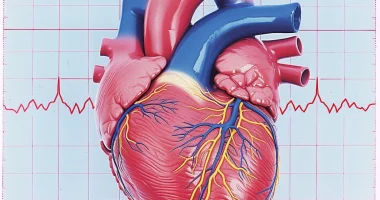Cerebral cavernous malformation (CCM)
Definition
Cerebral cavernous malformation is a vascular malformation consisting of blood-filled cavities in the brain or spinal cord. It manifests clinically in less than half of cases. The main symptoms include cephalgia, convulsive paroxysms, and cerebral hemorrhage. Diagnosis is carried out using electroencephalography, cerebral MRI, and angiography. Conservative treatment is carried out with the prescription of anticonvulsant drugs. Surgical tactics consist of complete excision of the cavernoma. When the malformation is deep, radiosurgery or laser obliteration may be used.
General information
According to the classification of vascular malformations, cavernoma refers to the cavernous form of hemangiomas. Previously, it was categorized as a neoplasm. Currently, it is considered an anomaly of vascular development. Cerebral cavernoma accounts for 10-15% of all CNS vascular malformations. More than 70% have supratentorial localization. The prevalence of cavernomas in the population does not exceed 0.5%. Clinically manifested cases of the disease are observed in 40-45% of patients, the rest are asymptomatic carriers of the anomaly. The detectability of the pathology has significantly improved with the introduction of neuroimaging methods into medical practice.
Causes
About 50% of cerebral cavernomas are hereditary, as proved by detecting pathology during MRI scans of the nearest relatives. In familial cases, the autosomal dominant type of inheritance is traced. Mutations of specific genes have been found to lead to the formation of cerebral cavernoma.
The etiology of sporadic cases remains unclear. It is believed that sporadic cavernoma is formed due to disorders of cerebral angiogenesis occurring at 3-8 weeks of intrauterine development. Triggers of the anomaly are any mutagenic factors acting on the pregnant woman’s body during this period. The main mutagens are intoxication, viral diseases, and medications with teratogenic effects.
Classification
According to etiology, cerebral cavernomas are classified into familial and sporadic. By localization within the brain, supra- and subtentorial forms are distinguished by quantitative characteristics – single and multiple. Microscopic study allows us to distinguish three basic histologic types of cavernous hemangiomas:
- Classic (type I) accounts for 94% of all cavernomas. The formation consists of caverns separated by connective tissue, and cerebral matter between the caverns is not identified.
- Mixed (type II): This condition occurs in 5% of patients and is characterized by interlayers of brain matter between the cavities. Poorly differentiated vascular elements are detected in some places.
- Proliferative (type III) is the rarest. Along with typical tissue, cavernoma contains areas of endothelial proliferation. In its structure, the latter type is similar to the morphology of capillary telangiectasias.
Symptoms
More than half of the cavernomas detected have an asymptomatic course. Symptomatic cavernoma can manifest at any age. The clinical picture depends on the localization and size of the vascular anomaly. The most typical manifestation is a seizure syndrome, observed in 63% of cases of the supratentorial form. Epi-seizures are present in 90% of patients when localized in the neocortex.
Epileptic paroxysms range from generalized to simple partial paroxysms. They are characterized by their relatively rare occurrence. Generalized epileptic seizures are typical for frontal localization and partial seizures – for temporal lobe cavernoma of the brain. In 34% of cases, there is a tendency to generalization and an increase in the frequency of epi-seizures with the course of the disease, despite anticonvulsant therapy. Resistance to anticonvulsants is most typical for malformations of temporal localization.
In some patients, general cerebral symptoms in the form of cephalgias of varying intensity come to the fore. Dysfunction of individual cranial nerves is possible. When the cavernoma is localized near the liquor pathways, there is an intense headache accompanied by increased intracranial pressure symptoms such as nausea, pressure on the eyeballs, and vomiting.
The location of the cavernoma in the deep parts of the cerebral hemispheres is manifested by focal symptoms: paresis, sensory deficit, and global aphasia. Cerebellar syndrome in the form of dysarthria, gross disorders of coordination, and gait is characteristic of cavernous hemangioma of the cerebellum. The most severe course is cavernoma of the brainstem. It is manifested by an alteration syndrome, oculomotor disorders, and bulbar symptoms.
Complications
Most often, a cerebral cavernoma is complicated by hemorrhage. Subarachnoid hemorrhage and formation of intracerebral hematoma are possible. Hemorrhage is manifested by the sudden appearance and rapid progression of focal symptoms. In some cases, there is a series of epi-seizures, turning into status epilepticus. Repeated hemorrhages lead to the formation of persistent neurological disorders. Brainstem hemorrhage can be fatal due to paralysis of the vascular or respiratory center.
Diagnosis
Asymptomatic cerebral cavernoma is diagnosed by a neurologist when undergoing an MRI for another disease or due to the presence of the diagnosis in a relative. With a symptomatic course in the neurological status, focal disorders, speech, and coordination disorders may be detected. Among the instrumental methods of investigation for the diagnosis of cavernomas in modern neurology are used:
- Electroencephalography (EEG) is mandatory for patients with epileptic paroxysms. It can detect typical forms of epileptical activity, high-amplitude flashes, and hypersynchrony of alpha and beta rhythms.
- CT scan of the brain. It diagnoses the presence of a voluminous rounded mass with clear boundaries. The heterogeneity of the structure indicates the presence of petrificates in the walls of caverns. It allows the diagnosis of hematoma and subarachnoid hemorrhage. However, it is low-informative in relation to medium- and small-sized cavernomas.
- MRI of the brain is the most informative method of diagnosing cavernoma. It visualizes malformation with 98% specificity. The images show the presence of a heterogeneous formation with clear contours and a typical low-intensity signal rim in T2 mode due to hemosiderin deposits.
- Angiography does not usually capture pathologic changes. It sometimes visualizes cavernoma as a vascular-free area. Angiography is used to exclude arteriovenous malformation, vascular tumor, and aneurysm.
- Histologic examination. This is performed on the material obtained during surgery. It reveals the presence of characteristic cavities and, in some cases, calcification and hemorrhages. It allows us to accurately verify the morphologic type of malformation.
Differential diagnosis
Cerebral cavernoma should be differentiated from intracranial tumor, aneurysm, and arteriovenous malformation (AVM). According to MRI, cerebral neoplasm is characterized by a steady increase in clinical symptoms, with sprouting into the surrounding tissues—indistinct boundaries of the formation. Unlike cavernomas, aneurysms and AVMs remain in the blood flow, so they are visualized during angiographic examination.
Treatment of cavernoma of the brain
Conservative therapy
Drug treatment is aimed at controlling the main manifestations of the disease. It is performed when the malformation is located in a functionally important brain area, in the absence of focal deficit, in patients with rare epileptic paroxysms. Conservative therapy is indicated after primary hemorrhage from a cavernoma of a functionally important area, providing full recovery of neurological functions.
Anticonvulsants are the basis of pharmacotherapy in patients with seizures. The drug is selected individually, and its dosage is adjusted depending on the frequency of the seizure. Treatment is carried out for a long time since discontinuation leads to the resumption or increase in the frequency of seizures.
Surgical treatment
The indication for surgery is cerebral cavernomas manifested by hemorrhage and localized outside of functionally significant areas. Suppose the cavernoma is located in a significant area. In that case, surgical intervention is recommended in case of severe epileptic seizures, repeated hemorrhages, progression of neurological deficit, and increasing signs of trunk lesions. The main methods of surgical treatment are:
- Surgical resection is the gold standard of treatment. The operation uses microsurgical techniques to completely remove the cavernous conglomerate. In case of incomplete removal, the remaining pathologic tissue serves as a source of hemorrhage and a trigger for epileptic activity.
- Stereotactic radiosurgery. It is indicated for deep cavernoma with the risk of damage to functional areas. The surgery can significantly reduce the incidence of hemorrhage.
- Stereotactic laser ablation is a relatively new treatment method with few clinical observations. It has been reported that this technique is effective for cavernomas located in surgically inaccessible areas.
All these treatment options are available in more than 600 hospitals worldwide (https://doctor.global/results/diseases/cerebral-cavernous-malformation-ccm). For example, Cavernous malformation treatment can be done in 28 clinics across Turkey for an approximate price of $10.5 K(https://doctor.global/results/asia/turkey/all-cities/all-specializations/procedures/cavernous-malformation-treatment).
Prognosis and prevention
In general, a benign course of cerebral cavernoma is observed. The focal deficit arising from the primary hemorrhage usually tends to regress completely. Repeated bleeding from the cavernoma entails disability of the patient. Complete excision of the malformation during surgery is guaranteed to prevent the occurrence of hemorrhage. In 60% of cases, this leads to a complete cessation of episodes and, in 20%, to a decrease in their frequency.
Specific measures for preventing cerebral cavernoma have not been developed. To prevent sporadic mutations, a protective regimen during pregnancy is necessary.


